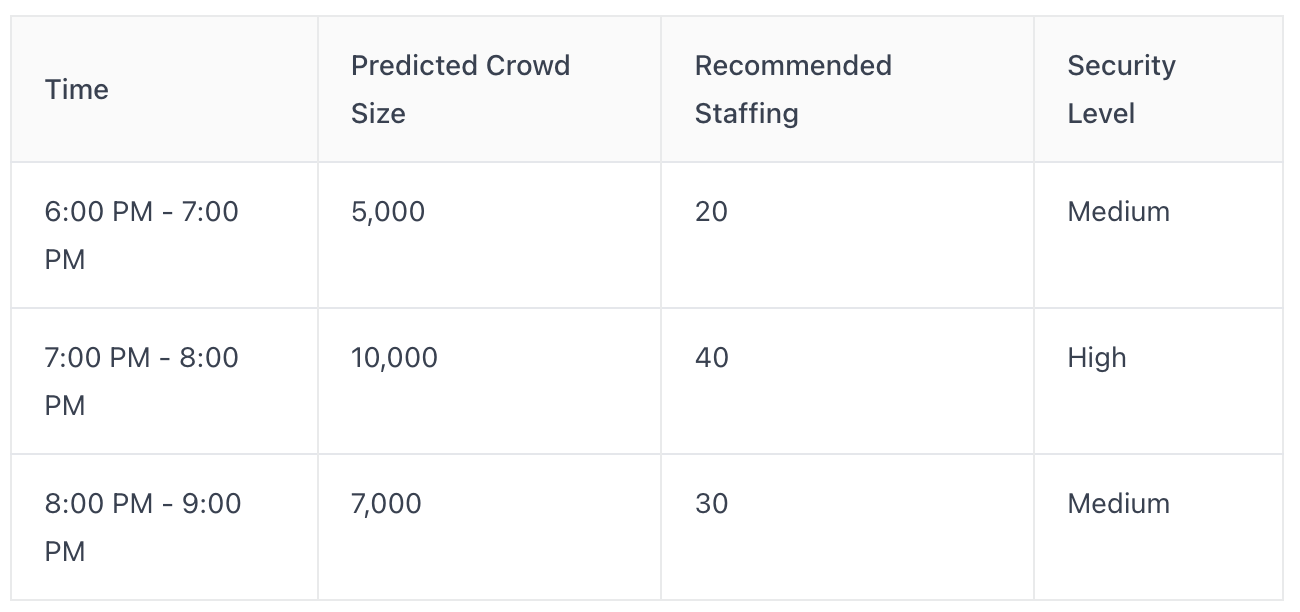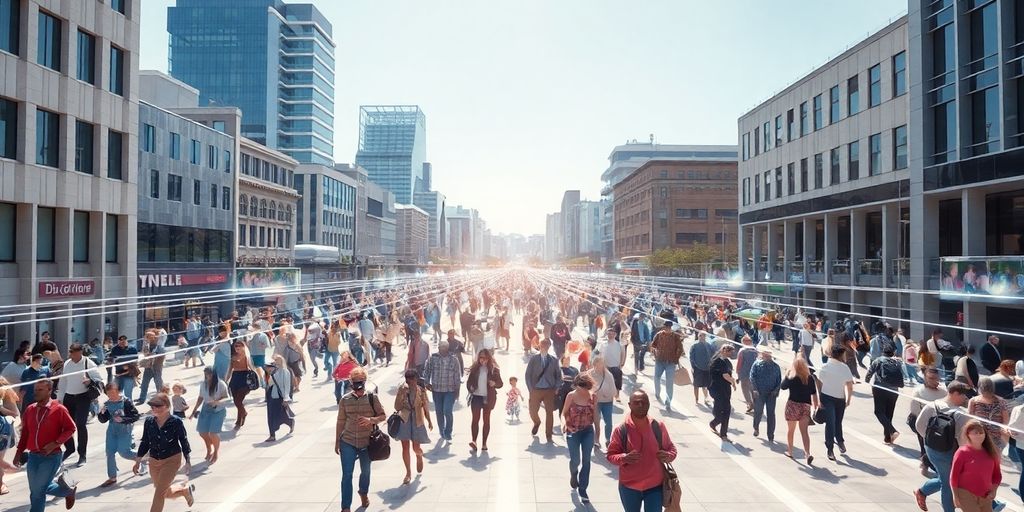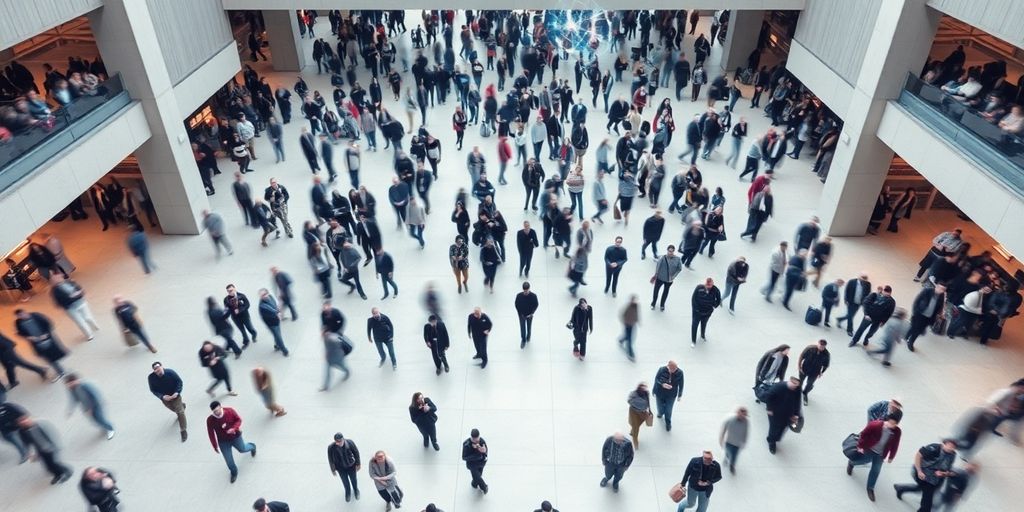Register as an organizer
Click the button below and finish your organizer registration, or fill out the form and we will be in touch to assist you.
.jpeg)
Imagine being able to see into the future of a bustling event, knowing exactly where crowds might gather and how to keep everyone moving smoothly. That's not science fiction anymore. With AI, we can now predict how large groups of people will behave. This helps prevent those annoying bottlenecks and makes sure everyone stays safe and has a good time. It's all about using smart technology to make big gatherings work better for everyone involved.
AI agents are basically smart software designed to do things that usually need a human brain. Think making decisions, solving problems, and learning from what happens. In crowd management, these agents look at data, guess how crowds will act, and then put plans in place to handle big groups of people well. They use algorithms and machine learning to process tons of data super fast. This helps them spot patterns that people might miss, so they can see problems coming and fix them before they get bad. AI crowd management software is a game changer.
One of the best things about AI agents is that they can watch and analyze data as it's happening. They use sensors, cameras, and other tools to get info on how many people there are, how they're moving, and where things are getting crowded. Then, they use this data to make quick decisions. This means you can react right away to problems, like telling people to go a different way if one area is too packed, or sending more staff to help where it's busy. This helps stop problems before they start, making events safer and smoother.
AI agents are great at guessing what will happen next. They use old data and current trends to predict the future. In crowd management, this means they can guess how people will act and spot possible dangers. For example, they can predict when the busiest times will be for entering and leaving, so organizers can get ready and make sure people don't have to wait too long. They can also give you insights into behavior by looking at data and finding trends.
Effective crowd management is super important for keeping people safe and happy at any event. If crowds aren't managed well, it can lead to problems like long lines, overcrowding, and even dangerous situations like stampedes. By using AI agents, event organizers can lower these risks and make sure everyone has a better time.
AI isn't just about reacting to what's happening now; it's about figuring out what's going to happen next. In crowd management, this predictive capability is a game-changer. By analyzing data, AI can forecast crowd behavior, allowing for proactive measures that prevent bottlenecks and ensure safety. It's like having a crystal ball, but instead of magic, it's powered by algorithms.
One of the most impactful uses of AI is predicting when and where crowds will be at their largest. Think about it: a concert venue, a busy train station, or even a popular shopping district. AI can analyze historical data, event schedules, weather forecasts, and even social media trends to anticipate peak congestion times. This allows organizers to adjust staffing, security, and traffic flow in advance, preventing overcrowding and potential hazards. For example, AI and ML are used to predict congestion times at entry and exit points, allowing organizers to adjust security measures and optimize traffic flow accordingly.
Knowing when and where crowds will gather is only half the battle. The other half is using that information to allocate resources effectively. AI can help optimize resource allocation by determining the optimal number of staff, security personnel, and even the placement of amenities like restrooms and food vendors. This ensures that resources are available where they're needed most, improving the overall experience for attendees and reducing operational costs.
Consider this scenario:

AI doesn't just predict; it enables proactive intervention. By identifying potential risks and bottlenecks before they occur, AI allows for the implementation of strategies to mitigate those risks. This could involve rerouting traffic, adjusting entry and exit points, or even sending targeted messages to attendees via mobile apps. The goal is to prevent problems before they escalate, ensuring a safe and enjoyable experience for everyone.
Imagine a scenario where AI detects a potential bottleneck forming near a concert stage. Instead of waiting for the situation to worsen, the system automatically adjusts the lighting to guide people away from the congested area, while also sending messages to nearby attendees suggesting alternative routes. This proactive approach can prevent a dangerous situation from developing.
AI-driven video analytics is super useful for keeping an eye on crowds in real-time. It lets authorities spot overcrowding, track how people are moving, and see any risky behavior. Think about big events like concerts or sports games. Video analytics systems can give live updates on how dense the crowd is, pointing out possible bottlenecks or areas that are too packed. By watching these things as they happen, event planners and security can quickly send help or guide people to safer spots, which lowers the chance of accidents or stampedes. Plus, these systems can also pick up on weird behavior, like sudden rushes or people running, which could mean there's an emergency. This early warning system means people can step in quickly, keeping everyone safer. This is especially useful for crowd density.
In places like airports, train stations, and shopping centers, it's really important to keep an eye on big groups of people. AI-powered video analytics helps security teams watch these areas all the time, spotting anything suspicious or any possible dangers. For example, if someone hangs around in a restricted area, leaves a bag unattended, or acts strangely, the AI system can immediately tell security to check it out. By giving instant alerts for unusual behavior, AI in video analytics helps stop potential security problems, making sure the public is safe. Also, AI systems can compare people against databases or security lists, quickly finding people of interest. This is super helpful in busy places where it's hard for people to watch everything effectively. Real-time threat detection is a game changer.
During emergencies, like fires, natural disasters, or public unrest, AI video analytics becomes a key tool for managing large groups of people. By looking at how crowds are behaving in real-time, AI systems can figure out the safest ways to get people out and guide them accordingly. For example, if one exit gets blocked or too crowded, the AI system can suggest other routes, which helps prevent panic and makes the evacuation smoother. AI video analytics also lets emergency responders see how big the crowd is, how fast they're moving, and how dense they are, so they can focus on the areas that need help right away. This real-time information is super important for keeping large groups safe, lowering casualties, and handling emergencies more effectively. It's all about live data.
AI video analytics is changing how we handle public safety. It's not just about watching; it's about understanding and reacting quickly to keep people safe. This technology is becoming more and more important in our daily lives.
Event management is a tough job, especially when you're dealing with lots of people. AI can really help make things smoother and safer. It's not just about counting heads; it's about understanding how crowds move and anticipating problems before they happen. Let's look at how AI can change the game.
AI helps event organizers keep things moving smoothly and safely. It's all about preventing bottlenecks and making sure everyone has a good experience. Think about a concert: AI can monitor crowd density in real-time and suggest opening up new entry points or redirecting people to less crowded areas. This keeps the flow going and reduces the risk of overcrowding. Effective crowd management is key.
AI can analyze data from past events to help organizers design better venue layouts. This means thinking about where to put stages, food vendors, and restrooms to minimize congestion and maximize flow. It's not just about guessing; it's about using data to make informed decisions. For example, if data shows that a particular area always gets crowded after a certain act, organizers can adjust the layout to alleviate that issue in future events. Data-driven decisions are the best decisions.
Getting people in and out of an event quickly and safely is crucial. AI can help streamline entry and exit protocols by predicting peak times and identifying potential bottlenecks. This allows organizers to open additional gates or adjust security protocols as needed. AI-driven systems can also provide real-time updates to attendees via mobile apps or digital signage, guiding them to less crowded entry points and reducing congestion. This not only enhances the attendee experience but also improves overall safety. Consider these points:
AI can also help with emergency planning. By simulating different scenarios, organizers can identify potential evacuation routes and develop strategies to quickly and safely move people out of the venue in case of an emergency. This proactive approach can save lives and minimize injuries.

AI in crowd management offers great promise, but it's not without its hurdles. We need to think about the ethical side, the tech limitations, and how to keep humans in the loop. It's not just about cool algorithms; it's about using them responsibly.
One of the biggest worries is data privacy. Using AI often means collecting and analyzing personal data, like through facial recognition or location tracking. This raises serious questions about how that data is stored, used, and protected. It's important to be upfront with people about what data is being collected and why. Event organizers need to follow data protection rules, like GDPR, and be clear about how they're using the information. Transparency builds trust.
AI isn't perfect. Its predictions are only as good as the data it gets. If the data is bad or incomplete, the AI will make mistakes. For example, if the AI cameras have poor image quality, the system might misinterpret crowd density. It's important to invest in good data collection and keep updating the AI with new information. Also, AI systems can be expensive to set up and maintain, which can be a barrier for some organizations.
AI can help, but it shouldn't be the only decision-maker. Humans need to be involved to check the AI's work and make sure decisions are fair and reasonable. AI can spot patterns, but humans can understand context and make judgments that AI can't. It's about finding the right balance between AI and human expertise.
It's important to remember that AI is a tool, not a replacement for human judgment. We need to use it carefully and ethically to make sure it benefits everyone.

AI's role in managing crowds is still developing, and it's expected to get way more advanced with things like faster internet and more connected devices. Think about it: wearable tech giving people real-time updates, robots helping control crowds, and traffic systems working with crowd control. It's all about making things safer and better for everyone.
As AI gets better, it's going to change crowd management a lot. We'll see more accurate predictions, better real-time monitoring, and smoother connections with event systems. This means organizers can handle crowds better, making events safer and more fun. Plus, more AI use could lead to new ideas and teamwork in the event world.
AI's future in crowd control will probably involve working with other new tech, like the Internet of Things (IoT) and 5G. By mixing AI with IoT devices, organizers can get more info on how crowds act and what the environment is like, helping them make smarter choices. And with 5G, data will move faster, improving how AI agents work in real time. This will make crowd management more flexible and responsive.
AI is set to change public events. It can spot patterns people might miss, helping to prevent problems before they happen. This means safer and smoother events for everyone. It's not just about safety, though. AI can also help make events more enjoyable by improving how people move around and access things. It's about using tech to make public experiences better overall.
AI is changing how we handle crowds, making events safer and more enjoyable. By using data and smart tech, we can create better experiences for everyone involved. It's an exciting time for event management, with AI leading the way to a more efficient and secure future.
So, we've talked a lot about how AI can help with managing crowds. It's pretty clear that this technology is a big deal for keeping people safe and making things run smoothly at events and in busy places. From predicting where bottlenecks might happen to helping emergency teams, AI gives us tools we didn't have before. Sure, there are things to think about, like making sure data is used correctly and that the tech works as it should. But as AI gets better, it's going to change how we handle large groups even more. It's all about making sure everyone has a good, safe time, and AI is definitely helping us get there.
AI agents are smart computer programs that help manage large groups of people. They use cameras and sensors to watch crowds, learn how people move, and then predict what might happen next. This helps event organizers keep everyone safe and things running smoothly.
AI helps by watching crowds in real-time, figuring out how dense they are, and seeing how people are moving. If an area gets too packed, the AI can alert staff so they can guide people to less crowded spots or open new paths. This stops problems before they get big.
Yes, AI can predict when crowds will be biggest, like at entry gates or food stands. By looking at past events and current information, AI can tell organizers when to have more staff ready or open more lines, making wait times shorter for everyone.
AI makes events safer by spotting unusual behavior, like someone running when they shouldn't be, or a sudden rush of people. It can send alerts to security teams right away, helping them respond quickly to potential dangers or emergencies.
While AI is super helpful, it's not perfect. It needs good quality information to work well, and sometimes there are privacy concerns about using cameras to watch people. Also, humans still need to be in charge to make final decisions and handle unexpected situations.
The future looks bright! AI will get even smarter, working with other tech like super-fast internet (5G) and smart devices. This means even better predictions, smoother crowd flow, and safer, more enjoyable experiences for everyone attending events.
More blogs
Click the button below and finish your organizer registration, or fill out the form and we will be in touch to assist you.